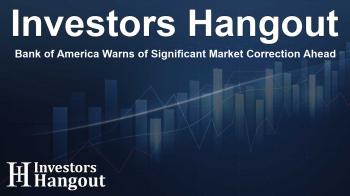Bank of America Warns of Significant Market Correction Ahead

Bank of America Issues Stark Warning About S&P 500
Bank of America strategists have issued a cautionary note regarding a potential 40% drop in the S&P 500, linking this prediction to the current growth-stock bubble.
Analyzing the Situation
The analysts drew parallels between the present market environment and past significant bubbles, specifically referencing the “Nifty Fifty” and the “dot-com” era. Their analysis includes an examination of current market conditions that suggest an impending correction.
Historical Comparisons
The report reveals significant market cap disparities, indicating that the U.S. stock market stands at 3.3 standard deviations from its historical average compared to global figures. Notably, the top five companies in the S&P 500 account for 26.4% of the overall index, raising concerns among investors.
Contributing Factors to the Growth-Stock Bubble
Bank of America’s Jared Woodard pointed to the surge in passive investing as a critical contributor to the current market concentration. With passive funds now holding a commanding 54% market share, Woodard expressed concerns over the potential lack of consideration for valuations and fundamentals that could lead to heightened risk during a downturn.
Insights from Other Financial Experts
Woodard’s insights align with views from other notable strategists on Wall Street. Figures such as Mike Wilson from Morgan Stanley and David Kostin from Goldman Sachs have similarly forecast a prolonged period of minimal returns for the S&P 500, reinforcing the concerns raised by Bank of America.
Strategies to Mitigate Risk
Despite the unsettling forecast, Bank of America has proposed a strategy for investors to potentially navigate the anticipated bear market effectively. They recommend focusing on the S&P 500 equal-weight index, investing in high-quality stocks that are less exposed to the so-called ‘Magnificent Seven,’ and striving for diversification within investment holdings.
The Broader Implications for Investors
The high concentration within the S&P 500 is increasingly a point of concern among investors and market analysts alike. The dominance of a limited number of stocks raises significant questions regarding market stability and health. Bank of America’s warning brings these issues to the forefront, suggesting the need for heightened awareness and strategic responsiveness from investors.
Lessons from Past Market Bubbles
The historical reference to the ‘Nifty Fifty’ and ‘dot-com’ bubbles serves as a poignant reminder of the potential consequences of a concentrated stock market. Previous bubbles have resulted in major market corrections and investor losses, suggesting that vigilance and adaptive strategies are paramount in the current landscape.
Navigating an Uncertain Market
While Bank of America's proposed strategies aim to assist investors in maneuvering through potential market turbulence, they also emphasize the importance of careful planning and responsive risk management in today’s volatile economic climate.
Frequently Asked Questions
Why does Bank of America predict a 40% drop in the S&P 500?
Bank of America attributes the potential drop to a growth-stock bubble, noting increased market concentration among top stocks.
What historical market situations are being compared to the current scenario?
The current situation is being compared to the ‘Nifty Fifty’ and ‘dot-com’ bubbles from previous decades, which experienced significant corrections.
What role does passive investing play in the current market concentration?
Passive investing has contributed to the market's high concentration, with a significant portion of capital flowing into a few major stocks.
How can investors mitigate risks in the current market?
Investors are encouraged to focus on diversified portfolios, quality stocks, and the S&P 500 equal-weight index to reduce concentration risk.
What should investors learn from past market bubbles?
Investors should remain vigilant of market cycles and prioritize risk management strategies to navigate potential downturns effectively.
About The Author
Contact Dominic Sanders privately here. Or send an email with ATTN: Dominic Sanders as the subject to contact@investorshangout.com.
About Investors Hangout
Investors Hangout is a leading online stock forum for financial discussion and learning, offering a wide range of free tools and resources. It draws in traders of all levels, who exchange market knowledge, investigate trading tactics, and keep an eye on industry developments in real time. Featuring financial articles, stock message boards, quotes, charts, company profiles, and live news updates. Through cooperative learning and a wealth of informational resources, it helps users from novices creating their first portfolios to experts honing their techniques. Join Investors Hangout today: https://investorshangout.com/
The content of this article is based on factual, publicly available information and does not represent legal, financial, or investment advice. Investors Hangout does not offer financial advice, and the author is not a licensed financial advisor. Consult a qualified advisor before making any financial or investment decisions based on this article. This article should not be considered advice to purchase, sell, or hold any securities or other investments. If any of the material provided here is inaccurate, please contact us for corrections.

